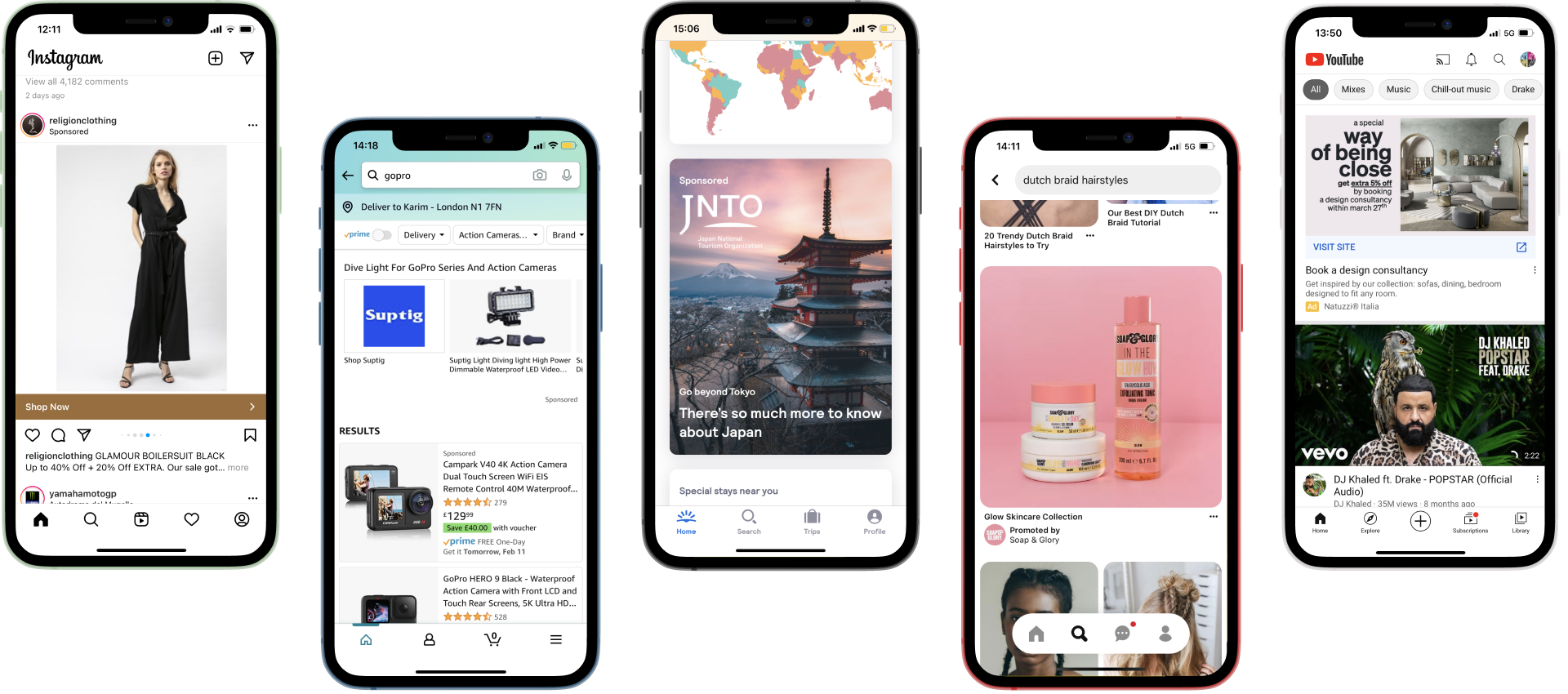
In-app Advertising
I have run a workshop to facilitate collaboration within Expedia Group teams about introducing advertising products on our apps.
The first part of the workshop was focused on illustrating the current market landscape to understand why introducing advertising products in apps is so important and how can those effectively help customers.
The second part of the session was focused on digging into ‘Advertiser’ and ‘Customer’ needs respectively to highlight commonalities that might point us in the right direction when brainstorming solutions.
Here I will focus on the market landscape and benchmark analysis.
Key features of the app experience
On-the-go
Ideal for a fast-paced society in constant movement
-
Immediate access
It is physically on the screen, one tap away. No need to type in web address or scrolling through different tabs. -
Focus
Users stay within the app. On web browser they can swap from one website to another. -
All in one place
Account details, previous orders, payment methods all saved in the app.
This allows a more optimised personalised experience.
Full device integration
Apps inherits the system specific capabilities
-
Fast sign-in
Through native ID recognition (eg. face ID, fingerprint, etc...) -
Native design and interactions
Users are familiar with the system interface; some websites might use components in different places (eg. "go back" button) -
Accessibility settings
-
Location
Tailored recommendations and quick access to services (eg. taxi apps) - Performance
Apps's speed is generally quicker than web
Engagement
Higher interaction and higher engagement value
-
Brand loyalty
the simple action of "downloading" the app shows commitment -
Notifications
ability to communicate with the User at any time -
Additional functionalities
such as "favourites" or "share", customer support, live chat - Immersive experience
More focus and native design make the experience more immersive

In-app Advertisement: Advertiser perspective
In-app Advertisement is considered the future of mobile advertising for 3 main reasons: audience, targeting and quality.
Audience
The audience is already on mobile, which is set to be the dominant channel and majority of digital users consume all their social media, lifestyle, travel, news and utility content using mobile apps.
Targeting
Features such as location data, Device ID and advanced campaign analytics make in-app ads a highly targeted path to reaching and converting users.
Quality
In-app ads are scaled to fit the app, looking much more appealing than mobile web ads.
5G will open the era of high-definition media and interactive technologies, allowing content to be displayed much faster than web.
In-app Advertisement: User perspective
Younger audience is ok with ads if the content is free
They understand why brands use ads to inform the public about their product and services, especially if the app/content is free3.
Auto-play videos are the considered the most disruptive ad format
Auto-play videos, modals, anchored banners and loading time of ads are considered extremely frustrating and slow down the content navigation.
Irrelevant content is just... annoying
And does not add any value to the User. Social media advertisement proved that relevant content is extremely effective and Users actively engage with it4.
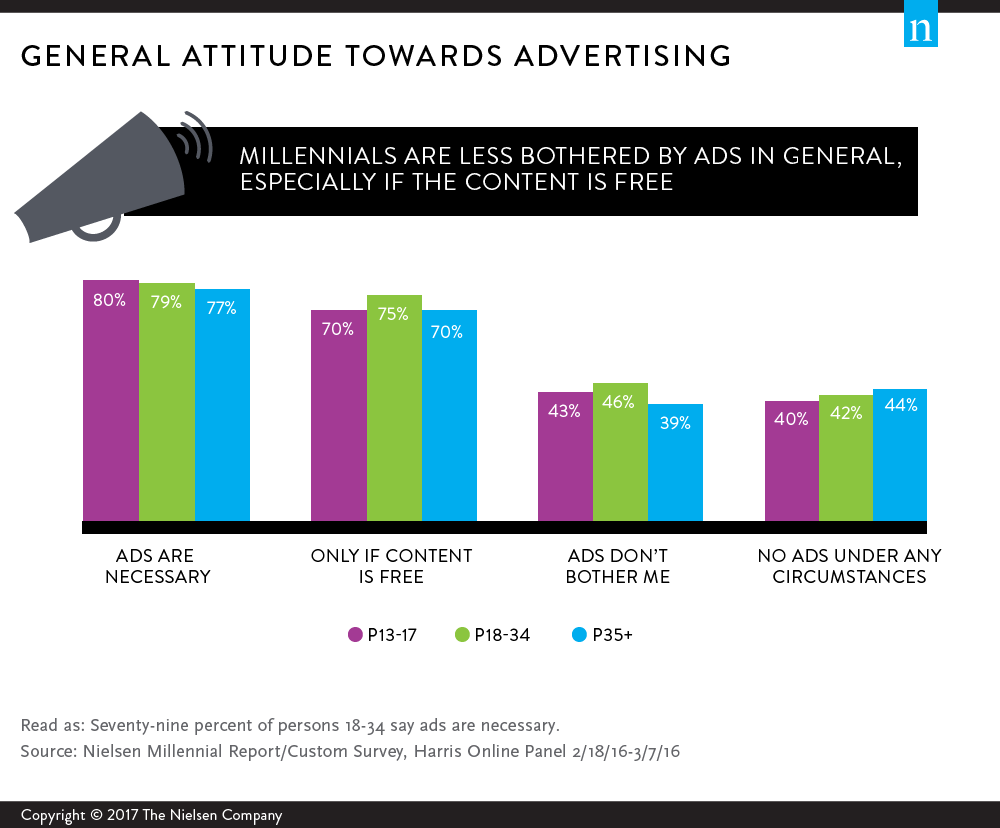
Ad formats
These are the most common Ad formats displayed in the apps that have been analysed in this study.
Display Banners
Banners are the Ad format most familiar to Users. Interactive Advertising Bureau (IAB) has created standardised guidelines on banner sizes, which work across all advertising networks.
Native Ads
The least intrusive ad format. They are designed to match the look and feel of the app, and the offers tend to relate to the function of the app or target your interests.
Native IAB
Standard Display banners which incorporate native elements of the website/app they are displayed in.
Interstitial Ads
Also called full-screen ads, they are images or videos shown during transitions in the app.
Sponsored products
Are ads for individual product listings. They appear at the top of shopping results pages and within product detail pages.


NATIVE AD

NATIVE IAB
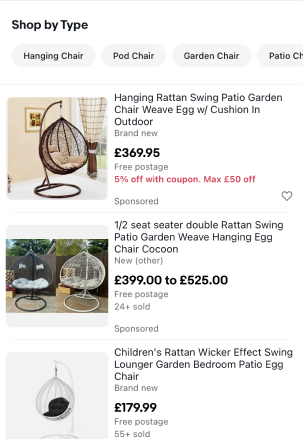
SPONSORED PRODUCTS
There are 3 additional Ad formats which are mostly used in gaming: they are Offer Wall, Playable Ads and Rewarded Ads.
A playable ad gives users a chance to briefly play a few minutes of another game they might like. Rewarded ads (like offer wall ads) incentivize users to watch a video, download, an app, or perform another action in exchange for in-game content.
Market landscape & Benchmark analysis
Apps analysed in this study:
- Social media
Facebook, Instagram, LinkedIn - Retail
Amazon, Ebay, Alibaba, Uber Eats, Waitrose, Asda - Entertainment
YouTube, Spotify, Pinterest
- Travel
Tripadvisor, Kayak, Skyscanner, Make My Trip
Not analysed in this study:
- News
- Gaming
- Health & fitness
Ads-heavy, large use of standard display banners, irrelevant content.
- Finance (eg. Personal banking)
Financial apps, such as Personal Banking, generally don't have ads, this is due to the highly sensitive content and personal data.
Although Partnerships are largely used.
Social Media
Average Ad exposure*
Social media apps goal: Communication, content browsing
They show Ads related to content that the User interacted with (liked) or searched on browser.
Any Ad could be relevant because while using the app the User browse various type of content.
- LinkedIn 40%
- Facebook 30%
- Instagram 20%
*Per page. It is referred to each section of the app (each tab) and the most commonly used.
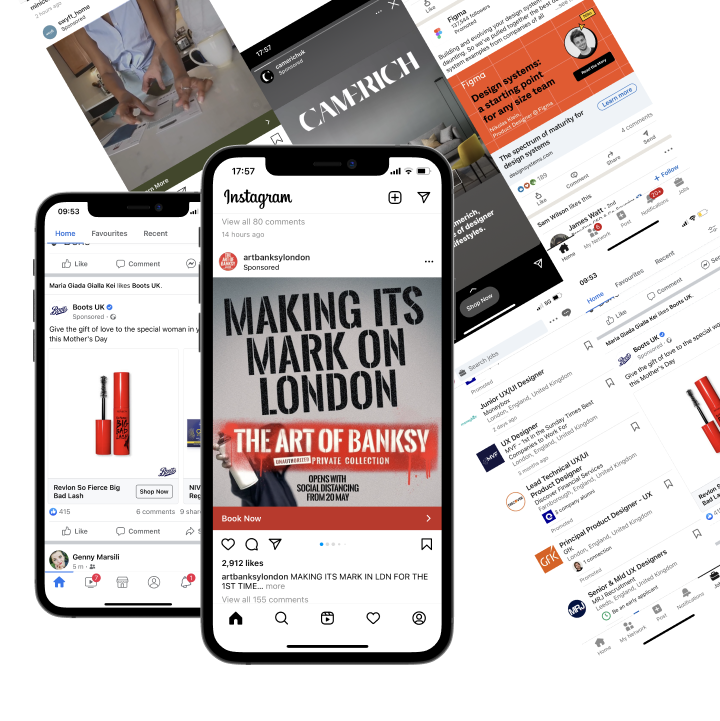
User Experience
Native Ads is the dominant format on home screens, perfectly integrated with the look and feel of the app.
LinkedIn also has Sponsored Ads in the "Jobs" section (respectively 2 organic - 2 sponsored jobs).
By selecting the Ads the User is taken to the advertiser's website through in-app browser modal, so will not leave the app.
The Sponsored Ads on LinkedIn lead the User to the Job description screen, same as per organic listings.
UX observations
Most of Social Media Users have at least made a purchase through one of the Ads displayed in their feed.
Advertisement in social Media is very effective and the target is almost perfect: in fact most of the ads are products/services that Users have been searching for on browser, so they are really interested in buying.
Although sometimes Users are targeted by ads which could be ethically offensive or misleading.
This is due to the huge amount of personal data that Users give to these apps (especially Facebook) when subscribing, so they might be targeted based on age, gender, location etc. Luckily the User is also able to report this content and choose to do not be exposed to similar content again.
Entertainment
Average Ad exposure
Entertainment apps goal: Entertainment, content browsing
It's worth mentioning that these apps might be used "hands off".
This represents a very important aspect, especially when Ads are displayed and there might be occasions where the User is not able to touch the screen so cannot "skip" or "close" the ad, this might disrupt the User Experience.
Ads in these apps can be relevant and related to the User search (Pinterest) or random and irrelevant in most cases.
- YouTube 50%
- Pinterest 33%
- Spotify 10%
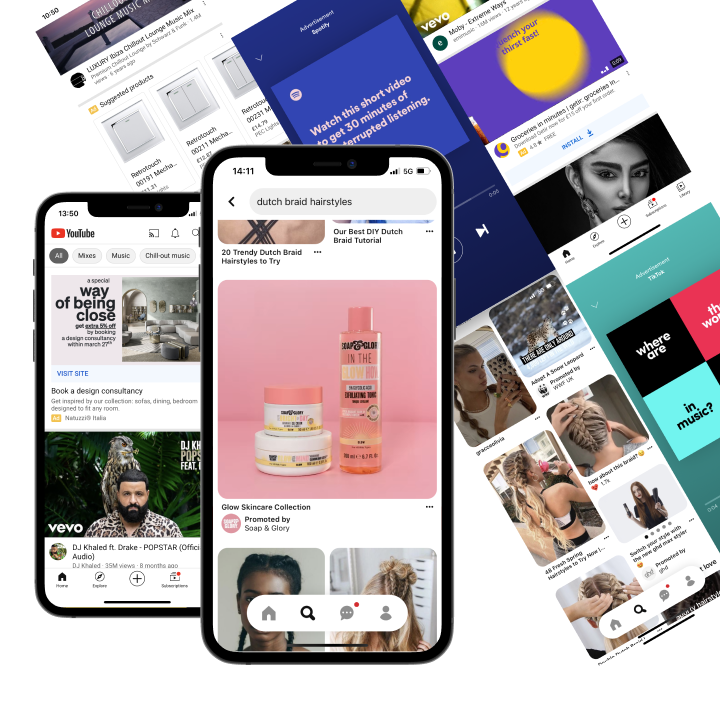
User Experience
Native Ads is the dominant format, followed by IAB Display and Interstitial Ads.
Pinterest: fully Native
All Ads are Native, displayed into the app masonry tiles, perfectly UI integrated. The Ad content is very relevant to the User search.
When selecting the ad the User is taken to the advertiser's website through in-app browser modal.
YouTube: IAB & Native Ads
High Ad exposure and mix of formats. On the home screen prevalently IAB display, when launching a video 80% of the time a video ad (native) is shown.
When selecting these Ads the User is taken out of the app, into web browser.
Spotify: Interstitial & Native Ads.
When launching the player the User is exposed to an interstitial ad, followed by a full screen video, then a native ad.
This process lasts about 1 minute, after that the User can enjoy 30 minutes of music.
UX observations
Pinterest Ad experience is generally good, considering that the app is mainly used as inspiration board for projects it is really good to see where you can buy the items you are looking for.
Advertisement which block the customer experience and does not allow the User to take any action is BAD UX.
YouTube UX can be really frustrating, especially because this app is used "hands off" most of the time. Sometimes the User cannot skip Ads, other times there are two video ads one after the other.
Once I was painting my room and I could not touch the screen to "skip" the video ad: I had to listen to a guy telling me how to make Billions by setting up my e-commerce site for 3 minutes... and it wasn't even finished. Well, I had to remove my gloves, exit the mobile app, open the laptop and turn on Ad-blocker
Retail
Average Ad exposure
Retail apps goal: Goods purchase
Users use these apps to purchase physical products.
There's a big difference in Ad exposure between traditional retailers and online only retailers: traditional retailers also own physical shops and their margin on products is much higher already.
- Amazon 45%
- Ebay 40%
- Alibaba 20%
- Waitrose 5%
- Asda 5%
- Uber Eats 3%
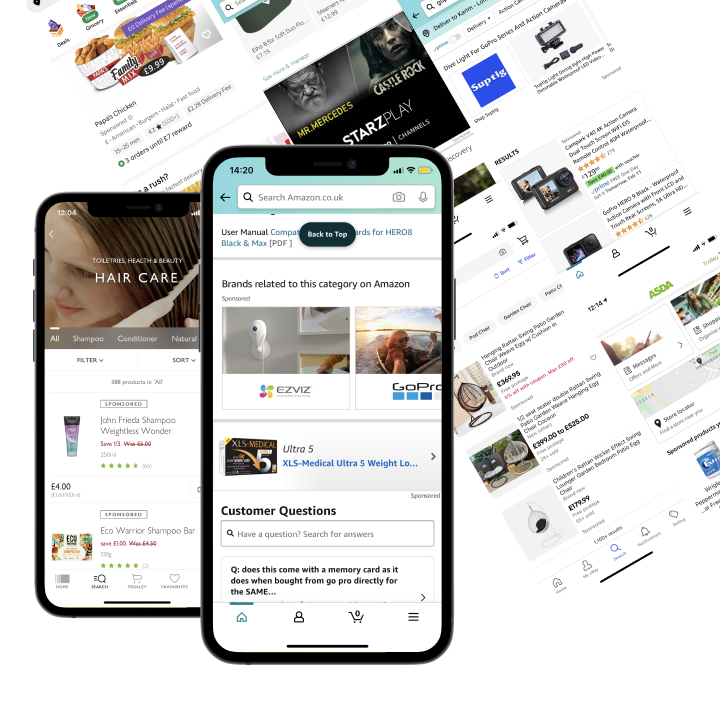
User Experience
Sponsored Ads is the dominant format, followed by Native.
Users are not simply browsing content on these apps, they are focused on making a purchase.
For this reason Standard Display banners are not largely used because they would distract customers from their primary goal and take them to an external website.
Sponsored Ads are a smart way of advertising in this context, by providing sponsored product similar to what the customer is looking for there is higher chance of conversion.
By selecting Sponsored Ads the User reach the "product details screen" exactly like any other product which is not "sponsored".
The curious case of Amazon
Amazon is the biggest online retailer and has a huge brand portfolio in continue expansion.
When using Amazon's apps Users often come across several x-sell products and advertisement without even noticing: brands and products don't have to be explicitly marked as an "advertisement" because they are owned by Amazon.
Travel
Average Ad exposure
Travel apps goal: Plan & book travel
Travel apps provide all Users need to plan and book a travel: inspiration, information, transportation and hotels prices.
- Tripadvisor 30%
- Make My Trip 30%
- Kayak 20%
- Skyscanner 3%
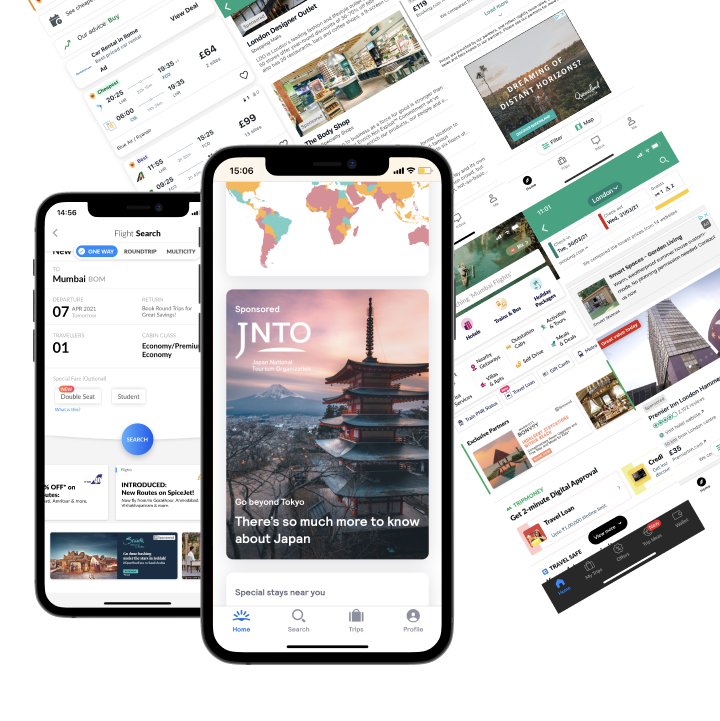
User Experience
Native Ads and Sponsored Ads are the dominant format, followed by Standard Display.
By selecting Native Ads or Standard Display ads the User will be taken to in-app browser screen which can be:
- The Partner's website: for Standard Display banners
- Landing page (mobile web version): for Native ads
Sponsored Ads are largely used and they keep the same experience as the organic content.
Key Findings
Ad exposure
Higher in apps that provide content or services
There's a higher amount of Ads in apps that do not sell any particular product or service, such as Social Media and entertainment.
The Ads exposure is lower in retail apps which have shops and sell/own physical products, because of their sales margin these brands do not have to rely on ads as much as online Marketplaces.
Ad content
The Ad content is more relevant on marketing apps
Retailers largely use Performance Ads in order to optimise conversion, the Ad content is highly targeted.
This Ad format is largely applied in Travel apps in order to provide more relevant content to the customer.
In Travel apps we always have travel-related content but sometimes it is not contextual to the User specific search.
Social Media and entertainment apps provide a mix of relevant and non-relevant content, the nature of these apps allows more flexibility in terms of content.
Task focus
Do not distract the User from their task
When using Retail or Travel apps the User is focused on completing a task, either buying a good or booking a trip. For this reason the type of Ad content is very sensitive, non-endemic ads can be very disruptive and distract the User from completing their task.
When using Social Media and entertainment apps instead, the User might not have a specific goal or outcome, they are not "task focused".
Hence ads can be less disruptive in their experience, as long as the ad exposure is not too high (eg. YouTube)
Do's & Don'ts
Consider the app function, its main goal
Distract the User from their primary task
Help Users by providing a good balance of suggestions
Exceed with the amount of Ads
Be relevant, relevance is the key
Display non-relevant content
Targeting: good targeting makes Users and Advertisers happy
Expose the entire audience to the same sponsored content
Thank You
Appendix
Sources
- https://medium.com/@the_manifest/how-in-app-advertising-works-for-app-monetization-2cce20497cf#:~:text=As%20the%20name%20suggests%2C%20in,navigate%20to%20in%20their%20browsers.
- https://www.thedrum.com/opinion/2020/04/06/why-mobile-app-advertising-the-future
- https://uxdesign.cc/how-to-implement-advertising-monetization-and-not-to-kill-ux-of-your-product-cd759f23868e
- https://www.bigcommerce.co.uk/blog/social-media-advertising/#the-6-best-social-networks-for-ecommerce-advertising
- https://neilpatel.com/blog/15-persuasion-lessons-you-can-learn-from-amazons-upsell-strategy/
